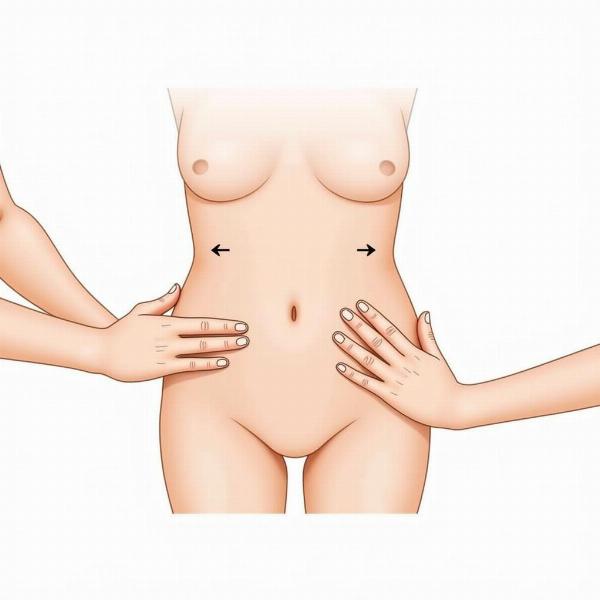Palpation, a fundamental diagnostic technique in medicine, involves the tactile examination of the body to assess various aspects of health. Understanding the meaning of palpation in Hindi, along with its practical applications, is crucial for both healthcare professionals and the general public in India. This guide explores the various facets of palpation, its significance in medical diagnosis, and the corresponding terminology in Hindi.
Understanding Palpation: स्पर्श परीक्षा (Sparsh Pariksha)
In Hindi, palpation is commonly referred to as स्पर्श परीक्षा (Sparsh Pariksha). The word “sparsh” means touch, while “pariksha” means examination. This aptly describes the process of using touch to gather information about the underlying tissues and organs. Palpation is a skill honed through practice, allowing medical practitioners to detect abnormalities such as swelling, tenderness, or changes in tissue texture.
Palpation is not limited to modern medicine; it has been an integral part of traditional Indian healing practices like Ayurveda for centuries. Ayurvedic practitioners utilize palpation to assess the doshas (Vata, Pitta, and Kapha) and identify imbalances that may contribute to illness.
Types of Palpation and Their Hindi Equivalents
Several types of palpation exist, each serving a specific purpose:
- Light Palpation (हल्का स्पर्श परीक्षा – Halka Sparsh Pariksha): Involves gentle pressure to assess surface characteristics like skin temperature and texture.
- Deep Palpation (गहरा स्पर्श परीक्षा – Gahra Sparsh Pariksha): Applies firmer pressure to examine deeper structures like organs and masses.
- Bimanual Palpation (द्विहस्त स्पर्श परीक्षा – Dwihast Sparsh Pariksha): Uses both hands to assess the size, shape, and mobility of organs, particularly in the abdomen and pelvis.
 Bimanual Palpation Technique
Bimanual Palpation Technique
Why is Palpation Important?
Palpation offers valuable insights into a patient’s condition, assisting in diagnosis and treatment planning. It can help detect:
- Swelling (सूजन – Sujan): Identifying areas of edema or inflammation.
- Tenderness (कोमलता – Komalta): Locating areas of pain or discomfort upon touch.
- Masses (गांठ – Ganth): Discovering abnormal growths or lumps.
- Organ Enlargement (अंग वृद्धि – Ang Vriddhi): Determining if organs are larger than normal.
- Pulse Rate (नाड़ी की गति – Nadi Ki Gati): Measuring the heart rate through palpation of the radial artery.
Palpation in Different Medical Specialties
Palpation plays a vital role across various medical specialties, including:
- Surgery: Identifying surgical sites and assessing post-operative healing.
- Internal Medicine: Examining the abdomen for organ enlargement or tenderness.
- Obstetrics and Gynecology: Assessing the size and position of the uterus during pregnancy.
- Orthopedics: Evaluating joint mobility and identifying areas of bone fracture.
What if Palpation Reveals an Abnormality?
If palpation reveals an abnormality, further investigations may be necessary. These can include imaging tests like ultrasound, CT scans, or MRI, or laboratory tests like blood work or biopsies.
Conclusion: The Power of Touch in Diagnosis
Palpation, or स्पर्श परीक्षा (Sparsh Pariksha), remains a cornerstone of medical examination. Its ability to provide crucial information about underlying tissues and organs makes it indispensable in diagnosis and patient care. Understanding the various forms of palpation and their Hindi equivalents empowers both medical professionals and patients alike.
FAQ
- What does palpation mean in simple terms? Palpation simply means examining the body by touch.
- Is palpation painful? Generally, palpation is not painful. However, if the area being examined is already tender, it might cause some discomfort.
- Can palpation be used to diagnose all medical conditions? No, palpation is a valuable tool but cannot diagnose all conditions. Further investigations are often required.
- What is the difference between light and deep palpation? Light palpation assesses surface characteristics, while deep palpation examines deeper structures.
- Why is it important to understand the Hindi meaning of palpation? Understanding the Hindi term, स्पर्श परीक्षा, helps facilitate communication between doctors and patients in India.
- Can I perform palpation on myself? While you can feel for obvious lumps or bumps, self-palpation is not a substitute for a professional medical examination.
- Where can I learn more about palpation techniques? Medical textbooks and online resources provide detailed information on various palpation techniques.
Meaning-Hindi.in is your trusted partner for professional translation services, specializing in various fields including medical, legal, technical, and website localization. We offer accurate and culturally sensitive translations between Hindi and other languages. Need help with translating medical documents or interpreting medical terminology? Contact us at [email protected] or call us at +91 11-4502-7584. Meaning-Hindi.in ensures your communication is clear, accurate, and effective.